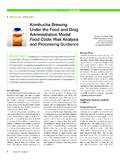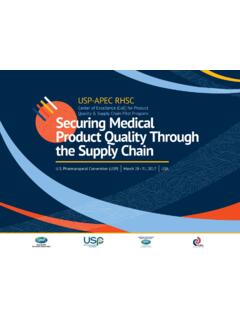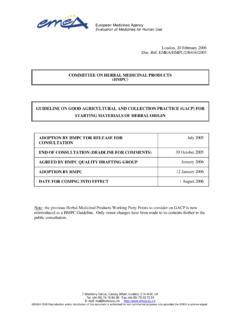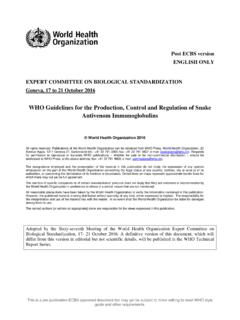Transcription of HACCP Principles & Application Guidelines
1 Food and Drug AdministrationProtecting and Promoting Your HealthHACCP Principles & Application GuidelinesAdopted August 14, 1997 NATIONAL ADVISORY COMMITTEE ONMICROBIOLOGICAL CRITERIA FOR FOODSThe National Advisory Committee on Microbiological Criteria for Foods (NACMCF) is an advisorycommittee chartered under the Department of Agriculture (USDA) and comprised of participants fromthe USDA (Food Safety and Inspection Service), Department of Health and Human Services ( Foodand Drug Administration and the Centers for Disease Control and Prevention) the Department ofCommerce (National Marine Fisheries Service), the Department of Defense (Office of the Army SurgeonGeneral), academia, industry and state employees.
2 NACMCF provides guidance and recommendations tothe Secretary of Agriculture and the Secretary of Health and Human Services regarding the microbiologicalsafety of OF CONTENTS EXECUTIVE SUMMARYDEFINITIONSHACCP PRINCIPLESGUIDELINES FOR Application OF HACCP PRINCIPLESI ntroductionPrerequisite ProgramsEducation and TrainingDeveloping a HACCP PlanAssemble the HACCP teamDescribe the food and its distributionDescribe the intended use and consumers of the foodDevelop a flow diagram which describes the processVerify the flow diagramConduct a hazard analysis (Principle 1)1 of 291 Determine critical control points (CCPs) (Principle 2)Establish critical limits (Principle 3)Establish monitoring procedures (Principle 4)Establish corrective actions (Principle 5)Establish verification procedures (Principle 6)Establish record-keeping and documentation procedures (Principle 7)
3 IMPLEMENTATION AND MAINTENANCE OF THE HACCP PLANAPPENDIX A - Examples of common prerequisite programsAPPENDIX B - Example of a flow diagram for the production of frozen cookedbeef C - Examples of questions to be considered when conducting a haz ard analysisAPPENDIX D - Examples of how the stages of hazard analysis are used to iden tify and evaluate hazardsAPPENDIX E - Example I of a CCP decision treeAPPENDIX F - Example II of a CCP decision treeAPPENDIX G - Examples of verification activitiesAPPENDIX H - Examples of HACCP recordsEXECUTIVE SUMMARYThe National Advisory Committee on Microbiological Criteria for Foods (Committee)reconvened a Hazard Analysis and Critical Control Point ( HACCP ) Working Group in1995.
4 The primary goal was to review the Committee's November 1992 HACCP document, comparing it to current HACCP guidance prepared by the CodexCommittee on Food Hygiene. Based upon its review, the Committee made theHACCP Principles more concise; revised and added definitions; included sections onprerequisite programs, education and training, and implementation and maintenanceof the HACCP plan; revised and provided a more detailed explanation of theapplication of HACCP Principles ; and provided an additional decision tree foridentifying critical control points (CCPs).The Committee again endorses HACCP as an effective and rational means ofassuring food safety from harvest to consumption.
5 Preventing problems fromoccurring is the paramount goal underlying any HACCP system. Seven basicprinciples are employed in the development of HACCP plans that meet the stated2 of 292goal. These Principles include hazard analysis, CCP identification, establishingcritical limits, monitoring procedures, corrective actions, verification procedures, andrecord-keeping and documentation. Under such systems, if a deviation occursindicating that control has been lost, the deviation is detected and appropriate stepsare taken to reestablish control in a timely manner to assure that potentiallyhazardous products do not reach the the Application of HACCP , the use of microbiological testing is seldom an effectivemeans of monitoring CCPs because of the time required to obtain results.
6 In mostinstances, monitoring of CCPs can best be accomplished through the use ofphysical and chemical tests, and through visual observations. Microbiological criteriado, however, play a role in verifying that the overall HACCP system is Committee believes that the HACCP Principles should be standardized toprovide uniformity in training and applying the HACCP system by industry andgovernment. In accordance with the National Academy of Sciencesrecommendation, the HACCP system must be developed by each foodestablishment and tailored to its individual product, processing and keeping with the Committee's charge to provide recommendations to itssponsoring agencies regarding microbiological food safety issues, this documentfocuses on this area.
7 The Committee recognizes that in order to assure food safety,properly designed HACCP systems must also consider chemical and physicalhazards in addition to other biological a successful HACCP program to be properly implemented, management mustbe committed to a HACCP approach. A commitment by management will indicate anawareness of the benefits and costs of HACCP and include education and training ofemployees. Benefits, in addition to enhanced assurance of food safety, are betteruse of resources and timely response to Committee designed this document to guide the food industry and advise itssponsoring agencies in the implementation of HACCP Decision Tree:A sequence of questions to assist in determining whether a control point is a :(a) To manage the conditions of an operation to maintain compliance withestablished criteria.
8 (b) The state where correct procedures are being followed and criteria are being Measure:Any action or activity that can be used to prevent, eliminate or reduce a of 291/20/16, 7:32 AM3 Control Point:Any step at which biological , chemical, or physical factors can be Action:Procedures followed when a deviation :A requirement on which a judgement or decision can be Control Point:A step at which control can be applied and is essential to prevent or eliminate a foodsafety hazard or reduce it to an acceptable Limit:A maximum and/or minimum value to which a biological , chemical or physicalparameter must be controlled at a CCP to prevent, eliminate or reduce to anacceptable level the occurrence of a food safety :Failure to meet a critical :A systematic approach to the identification, evaluation, and control of food Plan:The written document which is based upon the Principles of HACCP and whichdelineates the procedures to be System:The result of the implementation of the HACCP Team:The group of people who are responsible for developing, implementing andmaintaining the HACCP .
9 A biological , chemical, or physical agent that is reasonably likely to cause illness orinjury in the absence of its Analysis:The process of collecting and evaluating information on hazards associated with thefood under consideration to decide which are significant and must be addressed in4 of 291/20/16, 7:32 AM4the HACCP :To conduct a planned sequence of observations or measurements to assess whethera CCP is under control and to produce an accurate record for future use Programs:Procedures, including Good Manufacturing Practices, that address operationalconditions providing the foundation for the HACCP :The seriousness of the effect(s) of a :A point, procedure, operation or stage in the food system from primary production tofinal :That element of verification focused on collecting and evaluating scientific andtechnical information to determine if the HACCP plan, when properly implemented,will effectively control the :Those activities, other than monitoring, that determine the validity of the HACCP planand that the system is operating according to the PRINCIPLESHACCP is a systematic approach to the identification, evaluation, and control of foodsafety hazards based on the following seven Principles :Principle 1.
10 Conduct a hazard 2: Determine the critical control points (CCPs).Principle 3: Establish critical 4: Establish monitoring 5: Establish corrective 6: Establish verification 7: Establish record-keeping and documentation of 291/20/16, 7:32 AM5 Guidelines FOR Application OF HACCPPRINCIPLESI ntroductionHACCP is a management system in which food safety is addressed through theanalysis and control of biological , chemical, and physical hazards from raw materialproduction, procurement and handling, to manufacturing, distribution andconsumption of the finished product. For successful implementation of a HACCP plan, management must be strongly committed to the HACCP concept.






